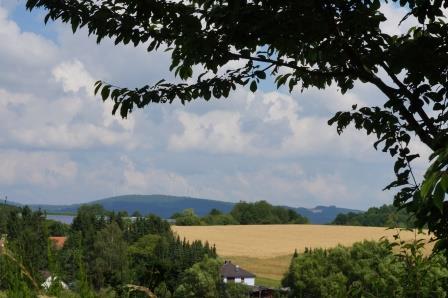
The Hoffmans originated from the town of Engschneider Hof in Tholey parish, Sankt Wendel, in Saarland, Germany. They were known as Wendelian Germans. Out immigrant ancestor, Nicholas Joseph Hoffman, the farmer who emigrated in 1848 with his 2nd wife, Katherine Hemmer and their daughter, Barbara, settled in the Sandy Hill area of Perkinsville (near the border of North Dansville) and were among the first settlers of that area. The original church and cemetery were built by Wendelians.
If you would like to see six generations desended from Mike’s 4th great grandfather, Johann Nikolaus Hemmer, please click on his name.
Here is a fascinating history that Rev. MacNamara posted on Genforum 26 Dec 2006:
Wendel (or Wendelin) was one of those many Irish ascetics and monks who originated in and immigrated from St. Patrick’s Ireland. He was the son of one of Ireland’s petty kings, born towards the middle of the sixth Century. A pious young man, Wendel made pilgrimage to Rome. Traveling home thereafter through Germany, he decided to settle down there as a hermit. The place he chose was Westricht in the German diocese of Trier, between the Rhine and Moselle Rivers.
When he had been there a while as a lone hermit, living in his little hermitage and spending most of his time in prayer, a local German landowner, evidently an exponent of the “work ethic” rebuked him for being a “do-nothing”. Wendel seems to have feared the attitude of this man who had no appreciation of the contemplative fife, so he asked him for a job. The landowner put him in charge of his pigs. Eventually, however – through a miracle, it is said – Wendel was released from this time-consuming task, and allowed to return to his professional life of prayer. Gradually his German neighbors began to realize that this was indeed a holy man, truly industrious in the spiritual sense. Indeed, people began to move into his vicinity, and Benedictine monks set up a monastery nearby at Tholey. Their town was eventually called Sankt Wendel.
After Wendel’s death, miracles began to be worked through his heavenly patronage, so a chapel was built to enshrine his tome. In 1320 the community prayed to him for preservation from the plague. The plague passed their town, so the archbishop of Treves, in gratitude, rebuilt the holy man’s chapel. This building was in turn replaced by a great gothic shrine-church. The people of that whole district, chiefly farmers by calling, adopted St. Wendel as the official patron saint of their work and their locality.
In the early decades of the nineteenth century, economic and social conditions began to deteriorate in the Rhineland. Consequently, many people from the diocese of Treves decided to move to America and start all over again.
A fair number of the Wendelians settled in the northwestern part of Steuben County, New York, and became active in growing the potatoes for which that district is noted. The first group arrived as early as 1832 in the town of Dansville, then a part of Steuben County. In 1834, two-thirds of the German community there fell victim to cholera. Nevertheless, by 1840, 40 men had arrived from Germany, many with their families. In 1838, the 17 pioneer families received a “church lot” on Sandy Hill, south of the present Perkinsville. Here they built a simple log church, surrounded by a graveyard. Begun in 1839, it was dedicated to Our Lady of the Holy Rosary on October 2, 1844. For a while this church served all the German Catholics in the neighboring countryside, by then numbering as high as 1,000. But by 1845 the Dansville Germans acquired their own St. Mary’s Church, and in 1850, Perkinsville, in the valley below Sandy Hill, built the Church of the Annunciation of the Blessed Virgin Mary. (Sacred Heart Church at Perkinsville is that parish’s second church building, dating from 1884).
The Sandy Hill Church was abandoned around 1851. The site of this church and cemetery is now marked by a large cross.
The lifestyle at Perkinsville was as much like that of Sankt Wendel in Germany as it was possible to make it. The people kept up their public eucharistic processions on the feast of Corpus Christi. They had their own parochial school, taught by German-speaking teachers, usually nuns. In fact, the village was so German that when its team played baseball with the team from Dansville, they played it in German as late as 1900!
If the Perkinsville church was not named after St. Wendel, at least it had a statue of him. In 1897, the German-born pastor, Father Alois Huber, obtained a relic of St. Wendel – a portion of his bones – from Bishop Felix Korum of Trier. Thus Irish-born St. Wendel established his physical presence among his German devotees who had moved their farms from the Moselle River country to the Cohocton River country.
May he continue to take care of their many descendants!
–Father Robert F. McNamara
Michael, Rebecca Grady and I were fortunate to visit Sankt Wendel in summer 2014 and spend a day with genealogist, Roland Geiger. We were even invited to attend the Corpus Christi procession with Roland’s family and to the church luncheon afterward. I’ll write about that lovely time soon!